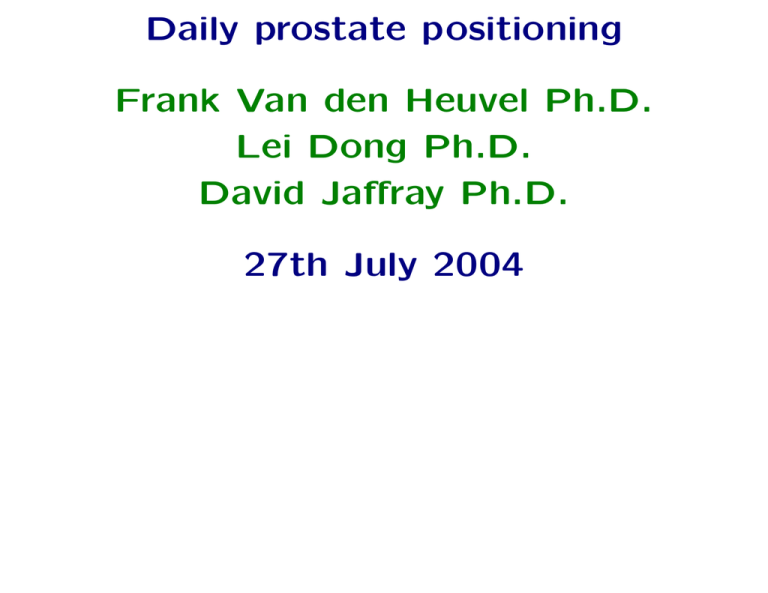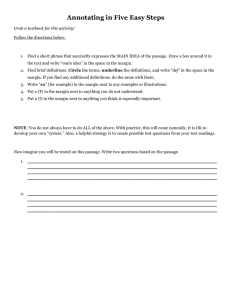Daily prostate positioning 27th July 2004 Frank Van den Heuvel Ph.D.
advertisement

Daily prostate positioning Frank Van den Heuvel Ph.D. Lei Dong Ph.D. David Jaffray Ph.D. 27th July 2004 • Measure with a micrometer. • Measure with a micrometer. • Mark with chalk. • Measure with a micrometer. • Mark with chalk. • Cut with an axe. • Measure with a micrometer. • Mark with chalk. • Cut with an scalpel. Now that we have IMRT. • Measure with a micrometer. • Mark with chalk. • Cut with an scalpel. Now that we have IMRT. But, we are very precise in determining the thickness of our chalk! The Goal of Image Guided Radiation Treatment The Goal of Image Guided Radiation Treatment Reduction of the PTV margin! The Goal of Image Guided Radiation Treatment Reduction of the PTV margin! The PTV margin depends on: • Organ • Patient • Modality of Treatment van Herk et al.[1] proposes a margin recipe, based on: van Herk et al.[1] proposes a margin recipe, based on: • Obtaining a 98% equivalent uniform dose (EUD) van Herk et al.[1] proposes a margin recipe, based on: • Obtaining a 98% equivalent uniform dose (EUD) • For 90% of the patients van Herk et al.[1] proposes a margin recipe, based on: • Obtaining a 98% equivalent uniform dose (EUD) • For 90% of the patients • Calculate this using a simulation procedure, using MC calculations to simulate population spread. Recipe: M = 2.5Σ + 0.7σ − 3mm van Herk et al.[1] proposes a margin recipe, based on: • Obtaining a 98% equivalent uniform dose (EUD) • For 90% of the patients • Calculate this using a simulation procedure, using MC calculations to simulate population spread. Recipe: M = 2.5Σ + 0.7σ − 3mm • Σ: Spread of the systematic errors SD(Σi ) van Herk et al.[1] proposes a margin recipe, based on: • Obtaining a 98% equivalent uniform dose (EUD) • For 90% of the patients • Calculate this using a simulation procedure, using MC calculations to simulate population spread. Recipe: M = 2.5Σ + 0.7σ − 3mm • Σ: Spread of the systematic errors SD(Σi ) • σ: Average of the random errors < σi > Reducing the Margin Reducing the Margin We can reduce Σ and/or σ Reducing the Margin We can reduce Σ and/or σ Reduction of Σ is most efficient and easiest to do Reducing the Margin We can reduce Σ and/or σ Reduction of Σ is most efficient and easiest to do Off Line Is the most popular correction system, to date. 1. Gather data to sample positional distribution (up to six fractions). 2. Apply a correction to minimize the systematic error. 3. Adapt margins to reflect the variations. On–line adjustment: reduces both Σ and σ at the same time. 1. No “bad” treatments 2. Conceptually simple, no assumptions on type of probability distributions How[2] Essentially all on–line adjustments are identical, only the modalities differ. 1. Patient is setup in treatment position. 2. The target organ (prostate) is detected and its position (or a representation thereof) is measured. 3. When a threshold offset is detected the patient is repositioned using a variety of methods. 4. A reassessment of the position is usually performed before start of treatment. On-line adjustment modalities • Ultrasound detection • Implanted Markers – – Active Passive ∗ US ∗ EPID Ultrasound adjustment Verification of Ultrasound based adjustment[3] • A total of 19 patients have been enrolled. • Compiled data of 17 patients will be presented. • 275 treatment setups with markers have been analyzed. • 156 image pairs using Ultrasound adjustment. • 119 image pairs using traditional treatment. 25 no BAT BAT 20 15 Antero-posterior (mm) 10 5 0 -5 -10 -15 -20 -25 -25 -20 -15 -10 -5 0 5 10 Cranio-Caudal (mm) Figure 1: Coronal Plane 15 20 25 25 no BAT BAT 20 Cranio-caudal (GT is positive) (mm) 15 10 5 0 -5 -10 -15 -20 -25 -25 -20 -15 -10 -5 0 5 10 Lateral (mm) Figure 2: Sagittal Plane 15 20 25 25 no BAT BAT 20 Antero-posterior (Up is positive) (mm) 15 10 5 0 -5 -10 -15 -20 -25 -25 -20 -15 -10 -5 0 5 10 15 Lateral (mm) Figure 3: Transverse plane 20 25 Why doesn’t Ultrasound aided repositioning perform better? Why doesn’t Ultrasound aided repositioning perform better? • User subjectivity[4]. Why doesn’t Ultrasound aided repositioning perform better? • User subjectivity[4]. • Discrepancy between contoured anatomy and actual anatomy[5]. Figure 4: Inter–observer variation of contouring bladder Why doesn’t Ultrasound aided repositioning perform better? • User subjectivity[4]. • Discrepancy between contoured anatomy and actual anatomy[5]. • Intra–fractional movement between the Ultrasound procedure and the treatment[6]. Why doesn’t Ultrasound aided repositioning perform better? • User subjectivity[4]. • Discrepancy between contoured anatomy and actual anatomy[5]. • Intra–fractional movement between the Ultrasound procedure and the treatment[6]. • Heisenberg ∆x∆p > h̄ 2 Improvements to reduce User subjectivity Improvements to reduce User subjectivity 1. BAT (Nomos Inc) • Live CT–contour projection during acquisition. • Seed localizers (Visicoil, Radiomed) Improvements to reduce User subjectivity 1. BAT (Nomos Inc) • Live CT–contour projection during acquisition. • Seed localizers (Visicoil, Radiomed) 2. Zmed (Varian Inc) • Pseudo 3D acquisition. • Live adjustment. Improvements to reduce User subjectivity 1. BAT (Nomos Inc) • Live CT–contour projection during acquisition. • Seed localizers (Visicoil, Radiomed) 2. Zmed (Varian Inc) • Pseudo 3D acquisition. • Live adjustment. 3. IBeam (CMS Inc) • Pseudo 3D acquisition and reconstruction. • Ultrasound contouring and export to planning system. Marker based protocols Marker based protocols Ultrasound Do not look for prostate, but look for long seeds (need 3D acquisition) EPID Take images and visualize the seeds Calypso Seeds reflect RF radiation use detector to see where they are. Assessment of marker daily repositioning The protocol used is as follows: 1. Obtain 2 images (45◦ and 315◦ ) using low exposure. Assessment of marker daily repositioning The protocol used is as follows: 1. Obtain 2 images (45◦ and 315◦ ) using low exposure. 2. Determine 3D position of the markers or any measure allowing to determine the position of the target w/ respect to the iso–center. Assessment of marker daily repositioning The protocol used is as follows: 1. Obtain 2 images (45◦ and 315◦ ) using low exposure. 2. Determine 3D position of the markers or any measure allowing to determine the position of the target w/ respect to the iso–center. 3. Calculate and perform shifts necessary to correct the patient’s position. Results An IRB approved study with 15 patients total accrual (currently 14 accrued) was initiated, using the abovementioned protocol. Results An IRB approved study with 15 patients total accrual (currently 14 accrued) was initiated, using the abovementioned protocol. Results shown here are for 10 patients. A total of 270 treatments were analyzed (27 fractions average per patient). Results An IRB approved study with 15 patients total accrual (currently 14 accrued) was initiated, using the abovementioned protocol. Results shown here are for 10 patients. A total of 270 treatments were analyzed (27 fractions average per patient). Every fraction had before and after measurements. Resulting in 540 total position measurements (270 before and after pairs). mean (mm) SD (mm) before AP 7.45 5.99 LAT 1.29 5.34 CC 5.12 4.44 after AP 0.65(P < 0.00001) 2.82(P < 0.00001) LAT 0.11(P < 0.00001) 2.64(P < 0.00001) CC 0.46(P < 0.00001) 2.22(P < 0.00001) Table 1: Pooled results, significance of reduction using t– test(mean) and F–test(Variances) After Before 30 20 AP (mm) 10 0 -10 -20 -30 -30 Figure 5: -20 -10 0 CC (mm) 10 20 30 Scatterplot showing before and after positions for a total of 540 measurements. All sizes are in millimeter. The ellipses cover 95% of all data points. Margin Calculations Σ (mm) σ (mm) Margin (mm) before AP 3.6 5.08 9.6 LAT 3.41 4.29 8.5 CC 3.88 2.36 8.4 after AP 0.56 2.64 LAT 0.39 2.37 CC 0.40 1.95 Table 2: Population statistics and margins calculated using 2.5Σ + 0.7σ − 3mm. Margin Calculations Σ (mm) σ (mm) Margin (mm) before AP 3.6 5.08 9.6 LAT 3.41 4.29 8.5 CC 3.88 2.36 8.4 0.25 after AP 0.56 2.64 LAT 0.39 2.37 CC 0.40 1.95 Table 2: Population statistics and margins calculated using 2.5Σ + 0.7σ − 3mm. Margin Calculations Σ (mm) σ (mm) Margin (mm) before AP 3.6 5.08 9.6 LAT 3.41 4.29 8.5 CC 3.88 2.36 8.4 after AP 0.56 2.64 0.25 LAT 0.39 2.37 -0.63 CC 0.40 1.95 Table 2: Population statistics and margins calculated using 2.5Σ + 0.7σ − 3mm. Margin Calculations Σ (mm) σ (mm) Margin (mm) before AP 3.6 5.08 9.6 LAT 3.41 4.29 8.5 CC 3.88 2.36 8.4 after AP 0.56 2.64 0.25 LAT 0.39 2.37 -0.63 CC 0.40 1.95 -0.64 Table 2: Population statistics and margins calculated using 2.5Σ + 0.7σ − 3mm. Figure 6: The model proposed by van Herk we are measuring. et al. is not valid at the values Important! Important! The residual errors observed were after the adjustment, but before the treatment. In order to gauge the efficacy of any repositioning scheme we need data during the treatment. Important! The residual errors observed were after the adjustment, but before the treatment. In order to gauge the efficacy of any repositioning scheme we need data during the treatment. We need to address the following problems: • Patient position at time of treatment (not before or after). • Treatment delivery. Important! Important! There are only two modalities that allow in–treatment patient monitoring. • EPID • Calypso They need to address the following problems: • Patient position at time of treatment (not before or after). • Treatment delivery. Calypso has the (not proven) capability to perform in–treatment monitoring of the position if the detector is built in the couch. Dose verification could be possible if combined with Radiation Dosimetry (Sicel Technologies Inc.) EPID can perform in–treatment position verification (even for IMRT) and intensity map verification, or even absolute measurement (A Radiation Dosimeter can replace one of the seeds). Figure 7: Portal Image of an IMRT treatment The previous image was taken using an electronic portal imager in cumulative mode (e.g. All frames taken are averaged). The previous image was taken using an electronic portal imager in cumulative mode (e.g. All frames taken are averaged). Intensity Modulation This information shows up as fairly large variations in contrast (steps are at least 5%). Patient Anatomy Small signals indicating bony edges or implanted markers. Other stuff Scattered radiation, source variations, (in short things we don’t want to see). 36000 Patient Image OpenImage 35500 PixelValue (arbitrary units) 35000 34500 34000 33500 33000 32500 32000 0 50 100 150 200 250 Pixel Number Figure 8: Cross–section of two images. One obtained during an IMRT–treatment (bottom) with the patient in place, the second without the patient (top). The major difference between the two signals is due to increased scattered radiation reaching the imager and decreased direct signal through patient attenuation of the primary dose. 35550 Image adjusted open field 35500 Imager response (arbitrary units) 35450 35400 35350 35300 35250 35200 35150 35100 0 Figure 9: 50 100 150 200 Pixel number 250 300 350 The same cross–section of two images as shown in Figure 8. The open field is scaled linearly to minimize the χ2 –goodness of fit. The fit is performed on the pixels inside of the field only. The good agreement outside of the field is likely due to chance and the fact that a small phantom will not change the out–of–field scatter significantly. (a) Treatment (b) Open Field (c) Subtracted Field Figure 10: Two–parameter adaptive subtraction, using identical image geometry. An open image was obtained using the intensity map, the phantom placed on the table was positioned in the beam and a new images was acquired. Practical application 1. Detect the field outline. 2. Adjust magnification and position of open field to match the original portal image. 3. Mathematical morphological erosion (to stay within the boundaries). 4. Minimize χ2 -function for all pixels within detected field. 5. Determine a and b. 6. Subtract adjusted open field from original portal image. 7. Renormalize values for display. Figure 11: Adjusted But wait! There’s more But wait! There’s more The final χ2 –value is sensitive to the intensity modulation function. If the incorrect value is used the value will be higher than normal. But wait! There’s more The final χ2 –value is sensitive to the intensity modulation function. If the incorrect value is used the value will be higher than normal. This allows to verify intensity modulated fields, if we know how they would interact with an electronic portal imaging device. Pixel j Pixel i Figure 12: The χ2 value is calculated along each line shown in this graphical representation. This is repeated for all pixels in the image. The “error”–map is generated by multiplying the four values, after which thresholding is performed. Pixels that remain highlighted indicate errors in the intensity map. Figure 13: Intensity map , With 6mm error introduced during 10% of the treatment Figure 14: 6mm leaf error introduced in 1 segment (10.11% of the treatment Figure 15: Fit map , thresholded to point out error in treatment Things to do • Determine adequate threshold values (ROC analysis). • Generate EPID-open fields. • Can we “pre–port”? Things to do • Determine adequate threshold values (ROC analysis). • Generate EPID-open fields. • Can we “pre–port”? Delivering a small amount of dose to the patient, mimicking the treatment at a smaller dose rate. Things to do • Determine adequate threshold values (ROC analysis). • Generate EPID-open fields. • Can we “pre–port”? Delivering a small amount of dose to the patient, mimicking the treatment at a smaller dose rate. what is an adequate pre-port amount 5MU? Acknowledgments • Therapists • Jesse Larrew • Pat McDermott • Part of this research was sponsored by the Uniformed Services University of the Health Sciences through Contract No. MDA905-92-C-0009 awarded to the Henry M. Jackson Foundation for the Advancement of Military Medicine. The content of the information does not necessarily reflect the position or the policy of the government, and no official endorsement should be inferred. References [1] M. van Herk, P. Remeijer, and J. V. Lebesque. Inclusion of geometric uncertainties in treatment plan evaluation. Int J Radiat Oncol Biol Phys, 52(5):1407–22., Apr 1 2002. [2] F. Van den Heuvel, W. De Neve, D. Verellen, M. Coghe, V. Coen, and G. Storme. Clinical implementation of an objective computer-aided protocol for intervention in intra-treatment correction using electronic portal imaging. Radiother. Oncol., 35:232–239, 1995. [3] Frank Van den Heuvel, Tanya Powell, Edward Seppi, Peter Littrupp, Mubashra Khan, Yue Wang, and Jeffrey D. Forman. Independent verification of ultrasound based image-guided radiation tre atment, using electronic portal imaging and implanted gold markers. Medical Physics, 30(11):2878–2887, 2003. [4] K. Langen, J. Pouliot, C. Azinos, M. Aubin, A.R. Gottschalk, I. Hsu, D. Lowther, K. Shinora, V. Weinberg, L.J. Verhey, and M. Roach. Evaluation of the use of the bat ultrasound system for prostate localization and repositioning: An inter–user study. Int J Radiat Oncol Biol Phys, 54(2 Suppl):316, October 2002. [5] G.J. Meijer, C. Rasch, P. Remeijer, and J.V. Lebesque. Three dimensional analysis of delineation errors, setup errors, and organ motion during radiotherapy of bladder cancer. Int J Radiat Oncol Biol Phys, 55:1277–1287, 2003. [6] J. Lattanzi, S. McNeeley, W. Pinover, E. Horwitz, I. Das, T. E. Schultheiss, and G. E. Hanks. comparison of daily localization to a daily ultrasound-based system in prostate cancer. Int J Radiat Oncol Biol Phys, 43(4):719–25., Mar 1 1999.








